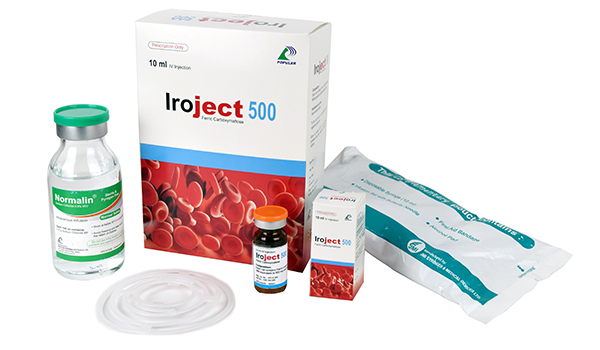Indication
Ferric Carboxymaltose is indicated for the treatment of iron deficiency anemia in adult patients:
• who have intolerance to oral iron or have had unsatisfactory response to oral iron
• who have non-dialysis dependent chronic kidney disease
Dosage & Administration
The posology of Ferric Carboxymaltose follows a step wise approach: Step-1: determination of the
individual iron need, Step-2: calculation and administration of the iron dose(s) and Step-3: post-iron
repletion assessments. This steps are outlined below:
Step-1: Determination of the individual iron need
The individual iron need for repletion using Iroject is determined based on patient’s body weight and
hemoglobin (Hb) level. The following Table-1 for determination of the iron need:
Table-1 for determination of the iron need:
Patient body weight | |||
Hb (g/dl) | below 35 kg | below 35 kg | below 35 kg |
<10 | 500 mg | 500 mg | 500 mg |
10 to 14 | 500 mg | 500 mg | 500 mg |
>14 | 500 mg | 500 mg | 500 mg |
Note:Iron deficiency must be confirmed by laboratory test
Step-2: Calculation and administration of the maximum individual iron dose(s)
Based on the iron need determined above the appropriate dose(s) of Ferric Carboxymaltose should
be administered taking into consideration the following:
A single Ferric Carboxymaltose administration should not exceed:
•15 mg Iron/Kg body weight (for administration by intravenous injection) or 20 mg Iron/Kg body weight
(for administration by intravenous infusion)
•1,000 mg of iron (20 ml Ferric Carboxymaltose)
•The maximum recommended cumulative dose of Ferric Carboxymaltose is 1,000 mg of iron per
week
Step-3: Post-iron repletion assessments
Re-assessments should be performed by the clinician based on the individual patient’s condition. The
Hb level should be re-assessed no earlier than 4 weeks post final Ferric Carboxymaltose
administration to allow adequate time for the erythropoiesis and iron utilization. In the event the
patient requires further iron repletion, the iron need should be recalculated using Table-1 above.
Method of Administration
Intravenous injection: Iroject may be administered by intravenous injection using undiluted solution.
The maximum single dose is 15 mg Iron/Kg body weight but should not exceed 1,000 mg of iron. The
administration rates are as shown in Table 2:
Table 2: Administration rates for intravenous injection of Iroject
Volume of Ferric Carboxymaltose required | Equivalent iron dose | Administration rate /Minimum administration time |
2 to 4 ml | 100 to 200 mg | No minimal prescribed time |
> 4 to 10 ml | > 200 to 500 mg | 100 mg iron / min |
>10 to 20 ml | > 500 to 1,000 mg | 15 minutes |
Intravenous infusion: Iroject may be administered by intravenous infusion, in which case it must be
diluted. The maximum single dose is 20 mg Iron/Kg body weight, but should not exceed 1,000 mg
iron. For infusion, Ferric Carboxymaltose must only be diluted in sterile 0.9% Sodium Chloride
solution as shown in Table 3.
Iroject must be administered only by the intravenous route: By bolus injection or during a
hemodialysis session undiluted directly into the venous limb of the dialyzer or by drip infusion. In case
of drip infusion Iroject must be diluted only in sterile 0.9% Sodium Chloride solution as follows:
Table 3: Dilution Procedure for IV Injection
Volume of Ferric Carboxymaltose required | Equivalent iron dose | Maximum amount of sterile 0.9% m/V Sodium Chloride solution | Minimum administration time |
2 to 4 ml | 100 to 200 mg | 50 ml | No minimal prescribed time |
>4 to 10 ml | >200 to 500 mg | 100 ml | 6 minutes |
>10 to 20 ml | >500 to 1,000 mg | 250 ml | 15 minutes |
Note: for stability reasons, Iroject should not be diluted to concentrations less than 2 mg Iron/ml.
Iroject must not be administered by the subcutaneous or intramuscular route.
Use in special population
Use in hemodialysis dependent chronic kidney disease: A single maximum daily injection dose of 200
mg iron should not be exceed in hemodialysis-dependent chronic kidney disease patients.
Use in paediatric population: The use of Ferric Carboxymaltose has not been studied in children, and
therefore is not recommended in children under 14 years.
Precautions
Serious hypersensitivity reactions, including anaphylactic-type reactions, some of which have been life-threatening and fatal, have been reported in patients receiving Ferric Carboxymaltose. Patients may present with shock, clinically significant hypotension, loss of consciousness, and/or collapse. Monitor patients for signs and symptoms of hypersensitivity during and after Ferric Carboxymaltose administration for at least 30 minutes and until clinically stable following completion of the infusion. Only administer Ferric Carboxymaltose when personnel and therapies are immediately available for the treatment of serious hypersensitivity reactions. Other serious adverse reactions associated with hypersensitivity which included, but not limited to,pruritus, rash, urticaria, wheezing, or hypotension may occur.
Hypertension
Transient elevations in systolic blood pressure, sometimes occurring with facial flushing, dizziness, or nausea were observed. These elevations generally occurred immediately after dosing and resolved within 30 minutes. Monitor patients for signs and symptoms of hypertension following each Ferric Carboxymaltose administration.
Laboratory Test Alterations
In the 24 hours following administration of Ferric Carboxymaltose, laboratory assays may
overestimate serum iron and transferrin bound iron by also measuring the iron in Ferric
Carboxymaltose.
Use in Pregnancy and Lactation
Pregnancy: There are no data for the use of Ferric Carboxymaltoxse in pregnant women. A careful
risk/benefit evaluation is required before use during pregnancy and Ferric Carboxymaltoxse should
not be used during pregnancy unless clearly necessary. Animal data suggest that iron released from
Ferric Carboxymaltose can cross the placental barrier and that its use during pregnancy may
influence skeletal development in the fetus.
Treatment with Ferric Carboxymaltose should be confined to the second and third trimester if the
benefit is judged to outweigh the potential risk for both the mother and the fetus.
Lactating mothers: Based on limited data on breast-feeding women it is unlikely that Ferric
Carboxymaltoxse represents a risk to the breast-fed child.

